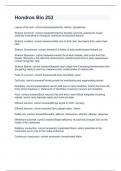Exam (elaborations)
Hondros Bio 253 exam with 100% correct answers 2024
- Course
- Institution
Layers of the skin correct answersepidermis, dermis, hypodermis Stratum Corneum correct answersProtective durable overcoat, waterproof, tough, relatively insensitive to biological, chemical and physical assault. Stratum Lucidum correct answersvisible only in thick skin, few layers thick, d...
[Show more]



